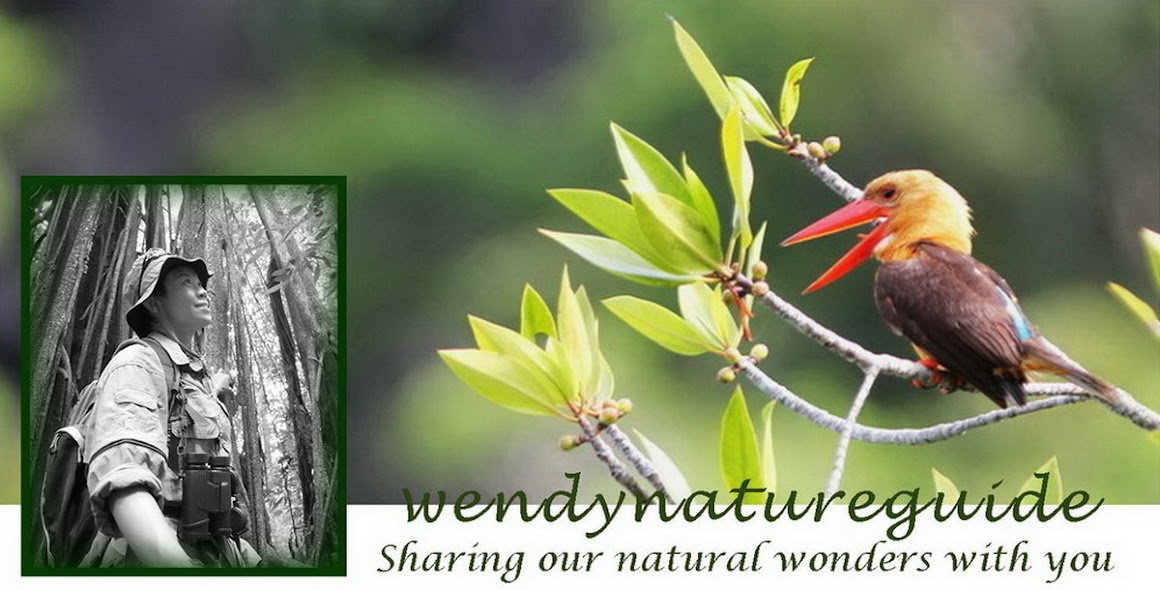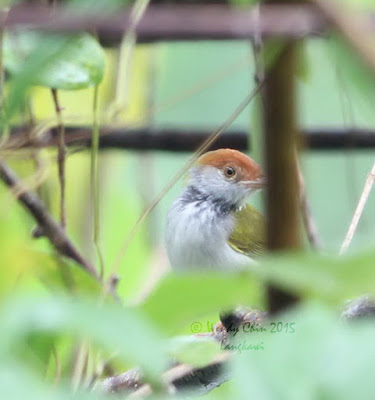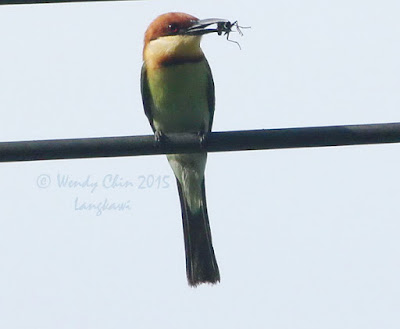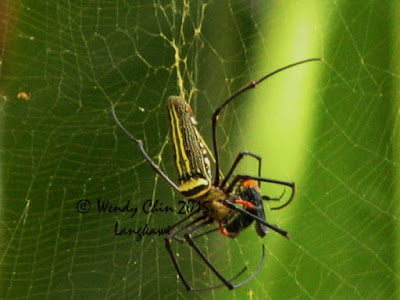I love the rain. Two to three hours of rain will make the wildlife scene more active. Even better if the heavy rainfall is in the night and the sun returns to shine in the morning.
I had a bird watching tour yesterday with a couple from Singapore. The weather was extremely hot and humid with clear blue sky. Great weather for many but not the bird life on the mountain. It was quiet and not even a call of the Puff-throated babbler Pellorneum ruficeps from the forest. However, we were lucky to photograph a Mountain Hawk Eagle Nisaetus nipalensis on flight.
An unexpected heavy rainfall at 2:45am that night brought the temperature down a little. It was nice and cooling.
Thankfully, the weather cleared up the next morning and so I was able to meet a family from Tunisia for their birdwatching tour with me.
On their wishlist was the Brown-winged kingfisher Pelargopsis amouroptera, so I took them to the nearest mangroves from their resort.
The Brown-winged kingfisher was already waiting on the branch as soon as our vehicle arrived at the car park area. They had at least a good twenty minutes to photograph this kingfisher and there were two of them! As the tide level was very favourable, this family was very fortunate to see this kingfisher without having to wait.
I joined them to photograph this special kingfisher of Langkawi. Our highlight was observing and photographing this individual with a crab caught in its beak.
 |
| Brown-winged kingfisher with its crunchy breakfast |
It smashed the crab on the tree branch and quickly devoured it. Due to its hard smashing, the crab split into another smaller portion and it dropped on the mud.
In the next minute, it descended onto the mudflat as if it has learned not to waste any food.
 |
| Kingfisher on the mudflat. Can you see the silvery shining object? Part of its breakfast |
 |
| It didn't pick up that portion of crab immediately. It turned to the right as if looking out for something. |
 |
| And then it turned again to look behind. Very funny... |
 |
| I think it finally felt secured to move forward to pick up its food |
 |
| Got it! |
 |
| Burp! |
This would be my first time photographing a Brown-winged kingfisher on a mudflat and it is not common for me to see this. Within the area, the Ashy Drongos were there and one Oriental Pied hornbill flew past. A Common Sandpiper and a Little Heron were spotted feeding on the another section of the mudflat.
And we had the joy of watching this Little Heron Butorides striata with its big fish!
 |
| Little Heron with a fish possibly a spotted garoupa |
 |
| Nothing is too big for this Little Heron to handle |
A very good start for the morning indeed. Thank you Brown-winged kingfisher and its associates! We then headed towards the mountain.
Gunung Raya was surprisingly more alive than yesterday! I would say it was the magical rain last night that made the difference. A pair of Wreathed Hornbills Rhyticeros undulatus flew out from the canopy and they were cooperative. They perched! The honking calls of the Great Hornbills Buceros bicornis were echoing through the forest. And alas! The singing call of the Puff-throated babbler Pellorneum ruficeps. The Singaporean couple were in my thoughts when I heard the babbler's call. They were looking for this bird yesterday.
While the Tunisian family were delighted over the Great Hornbills feeding on the strangling fig tree, I was ecstatic to see this migratory Brown Shrike Lanius cristatus lucionensis subspecies at the same area. I quickly ran back to the vehicle to grab my camera and luckily it was still there. This subspecies can be easily mistaken as the Grey-backed Shrike Lanius tephronotus. Even though I was excited seeing this lucionensis subspecies because it is uncommon here, I was also hoping that it was the L.tephronotus. Hopefully next time.
 |
| Brown Shrike Lanius cristatus lucionensis |
 |
| Brown Shrike Lanius cristatus lucionensis with its prey that looks like a grasshopper |
The family saw a few other species of birds on this mountain along with mammals like the Black Giant squirrel Ratufa bicolor, a troupe of Long-tailed macaques and Dusky leaf monkeys.
The mountain was getting quiet when noon arrived and it was time for us to descend to the rice fields. The family were so gung-ho to shoot the Red-Wattled Lapwings Vanellus indicus as close as possibly they can get, they walked down to the swampy area. While looking at a White-throated Kingfisher perched far away, they discovered a few unwanted guests crawling up on their shoes. Leeches!! They became restless and the mission of spending longer time on the swampy patch was abandoned. All of them were taking off their shoes checking for leeches and I helped to pick the leeches off them.
I got my lifer on that rice field area...Yay!! A Cinnamon Bittern Ixobrychus cinnamomeus flew out of the overgrown field and disappeared into the grass after about 10 meters of flight. A migrant with beautiful uniform rich cinnamon-rufous which is a very distinctive feature as compared to the Yellow Bittern Ixobrychus sinensis. However, I was not prepared with my camera and so no photo of my lifer.
The Yellow Bittern did show up in the end. Same like the Cinnamon, flew up and back into the field very quickly. The Common Kingfisher Alcedo atthis was very cheeky. It flew towards us and perched on a stick where we were less than five meters away. It made us overly excited till we were fiddling with our cameras. It took off in less than two seconds of perch. Oh well... that's wildlife photography in its natural setting...
The Mejri's bird sightings for this day:
1. Brown-winged Kingfisher 2. Brahminy Kite
3. House Swallow 4. Common Sandpiper
5. Little Heron 6. Ashy Drongo
7. Crested Goshawk 8. Common Myna
9. Oriental pied Hornbill 10. Spotted Dove
11. Wreathed Hornbill 12. Greater Racquet-Tailed Drongo
13. Great Hornbill 14. Thick-Billed Green Pigeon
15. Dollarbird 16. Brown Shrike lucionensis sp.
17.Scarlet-backed Flowerpecker
18. Chestnut-headed Beeeater
19. Cattle Egret 20. Little Egret
21. Red Wattled Lapwing 22. Great Egret
23. White-throated Kingfisher 24. Cinnamon Bittern
25. Black-naped Oriole 26. White-bellied Sea-Eagle
27. Blue-tailed Beeeater 28. Scaly-breasted Munia
29. Common Kingfisher 30. Intermediate Egret
31. Yellow Bittern
I would say that it was a productive morning and we graciously thanked the rain from last night.
Reference:
A field guide to the Birds of South-East Asia by Craig Robson
















































